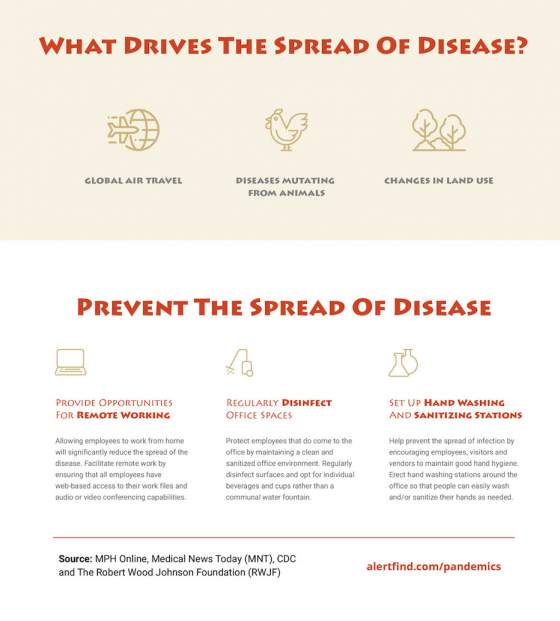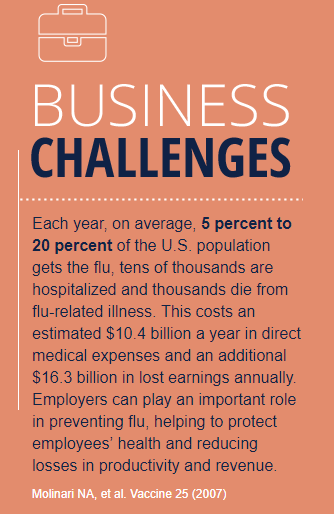1. Do you think the H1N1 virus will pose a serious risk to businesses this flu season?
The risk H1N1 poses to business is likely to be moderate, not serious. There’s a range of possibilities, but the likely scenario is that at least twice as many people will be stricken with flu this season, causing businesses to experience much higher-than-average absenteeism during peak periods. Scientific advisors to the White House recently warned that H1N1 may hospitalize 1.8 million Americans and infect as many as 50% of Americans.
Spikes in absenteeism may be associated with H1N1 infections peaking in a local community or metropolitan area.
Schools may close during peak periods, requiring working parents to care for their children during business hours.
buy fluoxetine online buy fluoxetine online no prescription
If public alarm becomes elevated, many people may refuse to travel by air or train, and some may be hesitant to leave their homes for work or other activities.
H1N1 influenza is very contagious, but it is not especially severe. At this time H1N1 causes most patients to experience a typical, not severe, course of flu symptoms. It seems unlikely that H1N1 will evolve into a virulent flu that causes atypically higher rates of hospitalization or death among infected patients. There is a “deadly virus” scenario that would pose a serious risk to businesses and society, but to date the evidence suggests that H1N1 will stay a relatively average virus in terms of severity.
2. What can businesses do to prevent the spread of such viruses in their workplace?
There are three practical steps to prevent H1N1 infection: wash your hands, cover your coughs, and isolate yourself if you’re sick. Businesses can help reinforce these messages with employee communications programs, and by visibly situating hand sanitizers and tissues in the workplace.
The best preventive measure by businesses is to encourage and require sick employees to stay home. It is important for persons to isolate themselves from the moment that they experience initial symptoms of flu. It is not OK to come to work if someone has symptoms but feels “good enough to work.” It is equally important for infected patients to stay home 3-4 days after symptoms of flu diminish, because they continue to be contagious after they feel better. People generally feel sick with H1N1 flu for 3-5 days after initial symptoms, so the recommended stay-at-home time is 8 days.
Employees who are unsure if they have H1N1 should be discouraged from coming into the workplace, and encouraged to see a physician for diagnosis and care.
The importance of “stay at home for 8 days” cannot be over-stated. Most people want to resume work after they feel better, and unless employers intervene, workers will return and infect their co-workers. Businesses should develop a policy and implement a strong communication plan for “stay for eight.”
3. What can companies do to conduct business as usual during a pandemic?
Businesses need a continuity plan for an H1N1 pandemic that addresses, “How will we operate with as many as 50% of our employees absent?” This includes policy development and communications, employee training and education, and operational planning. Businesses should prepare a plan for communicating during a pandemic to various constituents, including customers, employees and the community. Core functions such as IT and payroll may require special consideration.
As indicated above, infected patients with H1N1 should stay home for 8 days, but will feel better and able to work for roughly the last 4 days, even though they are still infectious. This creates a strong case for enabling workers to work from home using remote computing, if their role is amenable. This strategy could cut appropriate absenteeism in half, and even help prevent infection by employees returning to work too soon.
A Google search of “remote workers” will yield various data, checklists, and information on the ins-and-outs of remote working. If this makes sense for your business, you should begin developing plans and policies now.
An immediate action item is to determine if your employees have the resources they need, including equipment (company laptops, telephone headsets), connectivity (Internet broadband at home, or mobile data cards), software (virtual private network, remote computing, etc.), and training.
4. What can companies do to avoid last minute cancellations of events and meetings?
Meetings and travel will be among the first business activities affected by a pandemic. People will be hesitant to travel by air or any form of public transportation, and they may also be less willing to be separated from their homes and families. This may occur for a prolonged period, as an H1N1 flu pandemic rolls through various regions of the country or the world.
Businesses can take measures now to be prepared for cancellation of travel and meetings. They should take inventory of all meetings planned for a rolling 6 months, and carefully review current commitments. This includes a review of hotel or other contracts regarding cancellation terms and penalties, with special attention to milestone cancellation dates. Before signing new contracts, a provision for cancellation due to H1N1 should be included. Businesses should also carefully manage their air travel bookings, and avoid committing to air travel until it is necessary and economical.
Virtual meeting technology, such as webconferencing and videoconferencing, offers an effective alternative to travel-to meetings. Webconferencing in particular is both cost-effective and flexible enough to support late-breaking contingencies. The reliability and quality of webconferencing, including live video, have greatly improved thanks to advances in hardware, software and connectivity. Every business should begin using virtual meeting technology now to gain learning-curve experience, and select systems and vendors, so they have virtual meeting capabilities in place before an H1N1 pandemic strikes.
A recent and sudden temperature drop in New York over the past few days has provided an all-too obvious reminder: flu season is on its way. We will be discussing the specifics of dealing with H1N1 and pandemic preparedness in the November issue of Risk Management, but we wanted to be sure to give you plenty of information now as well, so that you can start planning as early as possible.
Bill Cooney, CEO of Medpoint Communications, was gracious enough to sit down with me recently to share some of his insights on the H1N1 preparedness. His “stay at home for eight” rule is something that may seem overly cautious, but he believes that it is necessary — and that it will greatly help your business navigate through the winter.
RMM: Do you think the H1N1 virus will pose a serious risk to businesses this flu season?
The risk H1N1 poses to business is likely to be moderate, not serious. There’s a range of possibilities, but the likely scenario is that at least twice as many people will be stricken with flu this season, causing businesses to experience much higher-than-average absenteeism during peak periods. Scientific advisors to the White House recently warned that H1N1 may infect 30% to 50% of Americans and hospitalize as many as 1.8 million Americans. For hospitals, a sudden spike in admitted patients would pose a serious business risk.
Increases in absenteeism may be associated with H1N1 infections peaking in a local community or metropolitan area. Schools may close during peak periods, requiring working parents to care for their children during business hours. If public alarm becomes elevated, many people may refuse to travel by air or train, and some may be hesitant to leave their homes for work or other activities.
H1N1 influenza is very contagious, but it is not especially severe. As with all flus, the severity of H1N1 varies by patient, but at this time H1N1 causes most patients to experience a typical course of flu symptoms. It is unlikely that H1N1 will evolve into a virulent flu that causes atypically higher rates of hospitalization or death among infected patients. There is a “deadly virus” scenario that would pose a serious risk to businesses and society, but to date the evidence suggests that H1N1 will remain a relatively average virus in terms of severity.
RMM: What can businesses do to prevent the spread of such viruses in their workplace?
There are three practical steps to prevent H1N1 infection: wash your hands, cover your coughs, and isolate yourself if you’re sick. Businesses can help reinforce these messages with employee communications programs, and by visibly situating hand sanitizers and tissues in the workplace.
The best preventive measure by businesses is to encourage and require sick employees to stay home. It is important for persons to isolate themselves from the moment that they experience initial symptoms of flu. It is not OK to come to work if someone has symptoms but feels “good enough to work.” It is equally important for infected patients to stay home 2-3 days after symptoms of flu diminish, because they continue to be contagious after they feel better. People generally feel sick with H1N1 flu for 3-5 days after initial symptoms, so the recommended total stay-at-home time is from 6 to 7 days.
Employees who are unsure if they have H1N1 should be discouraged from coming into the workplace, and encouraged to see a physician for diagnosis and care.
The importance of “stay at home for 6 to 7 days” cannot be over-stated. Most people want to resume work after they feel better, and unless employers intervene, workers will return and infect their co-workers. Businesses should develop a policy and implement a strong communication plan urging workers to wait at least 2 days after symptoms abate.
RMM: What can companies do to conduct business as usual during a pandemic?
Businesses need a continuity plan for an H1N1 pandemic that addresses, “How will we operate with as many as 50% of our employees absent?” (Note: it is unlikely, but possible, that 50% of workers will be absent at or near the same time.) A continuity plan should include policy development and communications, employee training and education, and operational planning. Businesses should prepare a plan for communicating during a pandemic to various constituents, including customers, employees and the community. Core functions such as IT and payroll may require special consideration.
As indicated above, infected patients with H1N1 should stay home for 6 to 7 days, but will feel better and able to work for roughly the last 3 days, even though they are still infectious. This creates a strong case for enabling workers to work from home using remote computing, if their role is amenable. This strategy could cut appropriate absenteeism in half, and even help prevent infection by employees returning to work too soon. There also may be healthy workers who stay home to care for children, or to avoid infection; this adds to the case for remote working.
A Google search of “remote workers” will yield various data, checklists, and information on the ins-and-outs of remote working. If this makes sense for your business, you should begin developing plans and policies now. An immediate action item is to determine if your employees have the resources they need, including equipment (company laptops, telephone headsets), connectivity (Internet broadband at home, or mobile data cards), software (virtual private network, remote computing, etc.), and training.
RMM: What can companies do to avoid last-minute cancellations of events and meetings?
Meetings and travel will be among the first business activities affected by a pandemic. People will be hesitant to travel by air or any form of public transportation, and they may also be less willing to be separated from their homes and families. This may occur for a prolonged period, as an H1N1 flu pandemic rolls through various regions of the country or the world.
Businesses can take measures now to be prepared for cancellation of travel and meetings. They should take inventory of all meetings planned for a rolling 6 months, and carefully review current commitments. This includes a review of hotel or other contracts regarding cancellation terms and penalties, with special attention to milestone cancellation dates. Before signing new contracts, a provision for cancellation due to H1N1 should be included. Businesses should also carefully manage their air travel bookings, and avoid committing to air travel until it is necessary and economical.
Virtual meeting technology, such as webconferencing and videoconferencing, offers an effective alternative to travel-to meetings. Webconferencing in particular is both cost-effective and flexible enough to support late-breaking contingencies. The reliability and quality of webconferencing, including live video, have greatly improved thanks to advances in hardware, software and connectivity. Every business should begin using virtual meeting technology now to gain learning-curve experience, and select systems and vendors, so they have virtual meeting capabilities in place before an H1N1 pandemic strikes.


 the previous estimate of 250,000 to 500,000. The estimates were drawn from a collaborative multinational survey conducted by the CDC and its global health partners.
the previous estimate of 250,000 to 500,000. The estimates were drawn from a collaborative multinational survey conducted by the CDC and its global health partners.